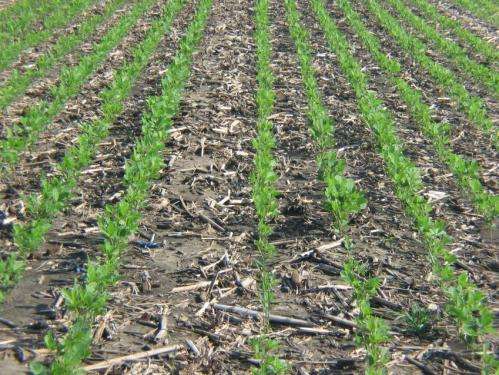Cover crops can sequester soil organic carbon

A 12-year University of Illinois study shows that, although the use of cover crops does not improve crop yields, the practice does increase the amount of sequestered soil organic carbon using three different soil management systems.
U of I soil scientist Ken Olson evaluated plots that were subjected to no-till, chisel plow and moldboard plow treatments with and without hairy vetch and cereal rye cover crops.
"By 2012, we found that the soil tillage plots that had cover-crop treatments had more soil organic carbon stock than those without cover crops for the same soil root zone and tillage treatment," Olson said.
In fact, Olson said that the no-till system, with cover crops, sequestered the most soil organic carbon when compared to the pre-treatment from the year 2000 no-till baseline soil organic carbon stock.
"In addition, the no-tilled, chisel plowed, and moldboard-plowed plots with cover crops all sequestered soil organic carbon above the pre-treatment baseline levels of the same tillage treatment."
With the addition of cover crops to all tillage treatments for the 12-year study, the soil organic carbon stock gains were 30 percent higher for no-till, 10 percent higher for chisel plowed, and 18 percent for moldboard-plowed plots.
"This suggests that soil organic carbon stock losses from tillage, water erosion, and some disturbance or mixing during no-till planting, aeration, nitrogen injection in corn years, and mineralization were less than the soil organic carbon gain from the cover-crop treatment," Olson said.
Olson stressed that establishing a baseline of soil organic carbon prior to the study is critical in order to claim that soil organic carbon is truly being sequestered.
"Management practices, such as no-till and cover crops, must create an increase in net soil organic carbon from a previous pre-treatment baseline, as well as result in a net reduction in atmospheric carbon dioxide levels to be described as having sequestered soil organic carbon," Olson said.
The study was conducted at U of I's Dixon Springs Agricultural Research Center in southern Illinois beginning in 2001 on sloping ground with a moderately well drained, eroded soil.
More information: "Long-Term, Effects of Cover Crops on Crop Yields, Soil Organic Carbon Stocks and Sequestration" was published in Open Journal of Soil Science.
Provided by University of Illinois at Urbana-Champaign



















